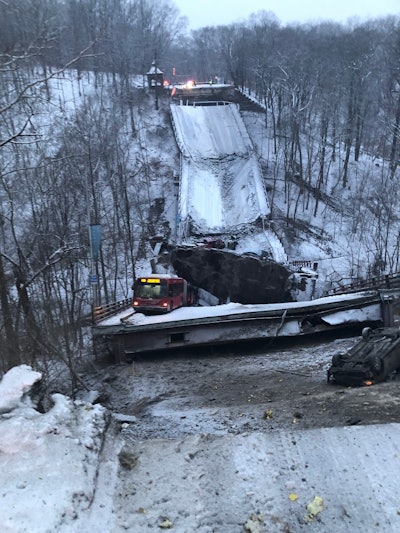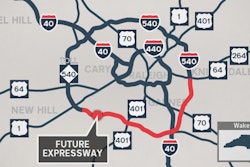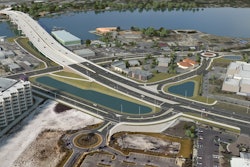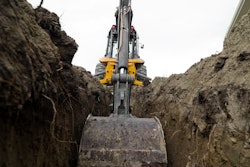
The collapse of the Fern Hollow Bridge in Pittsburgh in January 2022 while six vehicles were on it was due to “critical lapses in bridge maintenance and oversight by multiple agencies,” according to the National Transportation Safety Board.
The NTSB released the results of its two-year investigation February 21, which called out the City of Pittsburgh, the Pennsylvania Department of Transportation and the Federal Highway Administration for failures that led to the collapse that injured four people.
The 447-foot-long bridge collapsed January 28, 2022, due to a structural failure and fell about 100 feet to the park below. NTSB determined the cause to be a corroded transverse tie plate and section loss on the bridge’s southwest leg. Water and debris had continually run down the legs and accumulated at the bottom because of clogged drains. That prevented a protective patina rust layer from forming, NTSB said.
 Corrosion seen on leg of Fern Hollow Bridge in 2017 inspection.National Transportation Safety Board
Corrosion seen on leg of Fern Hollow Bridge in 2017 inspection.National Transportation Safety Board
Pennsylvania Department of Transportation contractors working on behalf of the city did not follow FHWA and AASHTO guidance when conducting inspections, NTSB said. They also failed to identify the legs and tie plate as being fracture critical to the bridge, so the legs and tie plate did not undergo more in-depth hands-on inspections. Fracture critical areas are those that could cause the bridge to collapse if they failed.
PennDOT contractors inaccurately calculated the bridge’s load ratings as well. Had the load ratings been accurate, according to NTSB, the bridge would have been required to be closed. The inaccurate load ratings centered on holes and section loss on portions of the bridge legs, estimates on the legs’ ability to resist buckling, and significantly underestimating the thickness of the asphalt wearing surface on the bridge at the time of collapse.
 Section loss seen in 2021 on a leg of the Fern Hollow Bridge.National Transportation Safety Board
Section loss seen in 2021 on a leg of the Fern Hollow Bridge.National Transportation Safety Board
NTSB released the following animation video with the report to detail its findings, including footage of the collapse from the surveillance video on a bus that was on the bridge:
The 50-year-old bridge had been rated as being in poor condition since 2011. It carried Forbes Avenue over Frick Park. It had a weight limit of 26 tons and was traveled by about 14,000 vehicles a day. NTSB described the bridge as “an uncoated weathering steel, three-span, continuous rigid ‘K’ frame structure with two welded steel girders, welded steel floor beams, and rolled steel stringers.” A replacement bridge has since been built.
“The Fern Hollow bridge catastrophe must serve as a wake-up call that we cannot take our infrastructure for granted,” said NTSB Chair Jennifer Homendy. “Only through diligent attention to inspection, maintenance, and repair can we ensure the roads, bridges, and tunnels we all traverse every day are safe for the traveling public. Lives depend on it.”
Recommendations
NTSB issued 11 recommendations to prevent a repeat of the collapse on other bridges and asked PennDOT to take the lead on their implementation and the city to work with PennDOT on the changes within their jurisdictions. The NTSB also made recommendations to the FHWA and AASHTO.
The recommendations are as follows, according to NTSB’s report:
To the Federal Highway Administration:
- Require state departments of transportation, as well as federal agencies and tribal communities that own and operate bridges, to conduct a one-time review of the existing fracture-critical member (nonredundant steel tension member) inspection plans for bridges with nonredundant steel frame leg designs in their inventory, and update these plans as necessary to ensure that all fracture-critical members, especially those in the legs, have been properly identified and accounted for in the fracture-critical member inspection plans and inspections.
- Update your Bridge Inspector’s Reference Manual to include guidance that addresses the identification of localized tension zones and tension components in nonredundant steel members that are generally considered to be fully or partially in compression.
- Update your Bridge Inspector’s Reference Manual and bridge inspection training courses to include reference material on the selection, frequency of use, and application of non-destructive inspection methods for assessing the wearing surface thickness on bridge decks.
- Establish a process for conducting targeted reviews of the safety issues identified in this investigation, to include at a minimum (1) an evaluation of bridge owners’ determinations of the need to conduct new load ratings of bridges with advancing deterioration, and (2) an evaluation of inspection reports on bridges with advanced deterioration to determine if the assumptions and methods used in the load rating calculations are correct; and incorporate the results of these reviews into the National Bridge Inspection Program Compliance Review Manual as necessary.
- Incorporate the findings of the Fern Hollow Bridge collapse investigation into your bridge inspection training courses and use the Fern Hollow Bridge as a case study to emphasize the need to complete maintenance and repair recommendations from inspection reports, follow guidance to ensure that bridge inspections are properly performed, correctly identify fracture-critical members, and correctly calculate load rating analyses.
To the Pennsylvania Department of Transportation:
- Lead the effort to evaluate and publish a report documenting the effectiveness of the changes made by the City of Pittsburgh to ensure that bridges are safe for the traveling public. Evaluated changes should include completing necessary bridge maintenance and repair recommendations and confirming that bridges have correct load ratings that account for deterioration.
- Develop and implement a plan to publish yearly aggregate data on bridge maintenance and repair recommendations to monitor completion of these recommendations.
To the City of Pittsburgh:
- Establish a system to ensure that you maintain paving records indicating how much asphalt wearing surface is removed and how much is subsequently placed during every bridge resurfacing operation.
- Work with the Pennsylvania Department of Transportation to evaluate the effectiveness of the changes made by the City of Pittsburgh to ensure that bridges are safe for the traveling public. Evaluated changes should include completing necessary bridge maintenance and repair recommendations and confirming that bridges have correct load ratings that account for deterioration.
To the American Association of State Highway and Transportation Officials:
- Update your Manual for Bridge Evaluation to include guidance that addresses the identification of localized tension zones and tension components in nonredundant steel members that are generally considered to be fully or partially in compression.
- Update your Manual for Bridge Evaluation to include reference material on the selection, frequency of use, and application of non-destructive inspection methods for assessing the wearing surface thickness on bridge decks.
The report also reiterated a previous recommendation to the National Federal Highway Administration to develop a risk-based, data-driven process and encourage its use by state departments of transportation, as well as highway-bridge-owning federal agencies and tribal governments, to help them identify, prioritize, and perform follow-up actions documented in inspections of bridges with uncoated weathering steel components.











